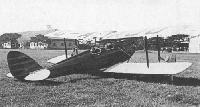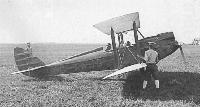Фотографии
-
A Nieuport Scout of the Siamese Air Force at Don Muang. The spiral marking on the fuselage is the Siamese numeral 1. Nieuports remained in service as trainers until about 1933. At the top of the picture de Havilland D.H.60G Gipsy Moth G-AAJO arrives overhead.
Самолёты на фотографии: De Havilland Gipsy Moth / Moth X - Великобритания - 1928Nieuport Nieuport-17/21/23 - Франция - 1916
-
Two Siamese Air Force Paribat general-purpose biplanes. The Paribat was a Siamese design; the example in the foreground, bearing the Thai number 2 on its tail, was powered by a nine-cylinder Bristol Jupiter radial engine. The Paribat in the background is believed to be fitted with a BMW VI or VII 12-cylinder vee engine.
Самолёты на фотографии: Vejayanrangsrit Boripatra - Таиланд - 1927
-
Three Paribats flew to India in 1930 in return for an RAF goodwill visit from India to Siam. On the way back to Don Muang one of the Paribats crashed in the jungle somewhere near the border between Siam and Burma. The other two, Nos 2 and 4, returned to the rapturous reception shown in these photos.
Самолёты на фотографии: Vejayanrangsrit Boripatra - Таиланд - 1927
-
Paribat No 2 just after landing. Note the flag-carrying marshallers.
Самолёты на фотографии: Vejayanrangsrit Boripatra - Таиланд - 1927
-
The arrival of the BMW-powered Paribat, bearing the Siamese number 4 on its fin.
Самолёты на фотографии: Vejayanrangsrit Boripatra - Таиланд - 1927
-
Самолёты на фотографии: Vejayanrangsrit Boripatra - Таиланд - 1927
-
Регистрационный номер: G-AAJO [3], ZK-ADT [3] The trio in front of Moth G-AAJO consists of, left to right: senior Siamese Air Force officer Nai Chert; the Hon Mrs Victor Montague, and her copilot the Hon Rupert Bellville. The latter two had hired the Moth from its owner, the Hon Loel Guinness, for a tour of China, leaving Heston on August 18, 1932. On the port fuselage side of G-AAJO, directly below the cabane struts, was a painting of a siren or mermaid. She wore a coronet on her head and a white bow on her tail, and carried the emblem of 601 (County of London) Squadron - “The Millionaires' Mob” - in her left hand. Regrettably, reports Mr Clennell, “the Siamese did not like it very much".
Самолёты на фотографии: De Havilland Gipsy Moth / Moth X - Великобритания - 1928
-
Регистрационный номер: G-AAJO [3], ZK-ADT [3] G-AAJO warming up and preparing to depart for Rangoon. The last recorded owner of the Moth was Heston-based Stanley G. White. He acquired it on August 27, 1934 and flew it to Australia that November, where he had it re-registered ZK-ADT and named Huia.
Самолёты на фотографии: De Havilland Gipsy Moth / Moth X - Великобритания - 1928
-
Регистрационный номер: G-AAJO [3], ZK-ADT [3] Самолёты на фотографии: De Havilland Gipsy Moth / Moth X - Великобритания - 1928
Статьи
- -
- Grapevine
- NA P-51D Mustang 45-11582 /Preservation Profile/
- Personal album
- A.Lumsden, T.Heffernan - Probe Probare (25)
- B.Robertson - A present from... (2)
- C.Read - Dunlop diversions (2)
- F.Bullmore - Circus Pilot (2)
- J.Stroud - Wings of Peace
- P.Chinnery - The Air War over Vietnam (6)
- P.Skinner - A ride in the Lancaster
- R.Nesbit - Arctic Venture (5)
- W.Fillingham - On testing the Chipmunk
- W.Morse - The Rotary Revolution (4)








